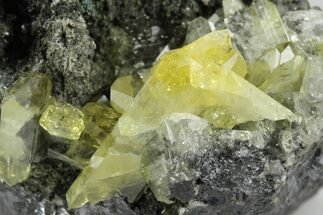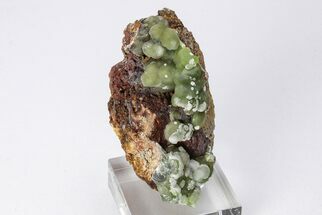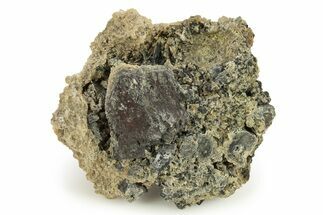This Specimen has been sold.
3.4" Botryoidal Green Smithsonite - Hidden Treasure Mine, Utah
This specimen contains botryoidal green smithsonite, with calcite crystals peppered along what could be considered the underside of the specimen. It was collected from the Hidden Treasure Mine in the Ophir District of Utah, a location that's well known for its zinc and copper mineral deposits.
It comes with an acrylic display stand.
It comes with an acrylic display stand.
Smithsonite forms in earthy botryoidal masses, sometimes forming grape-like structures. It can be found as a secondary mineral in oxidation zones of zinc ore deposits, in some sedimentary deposits, and as an oxidation product of sphalerite. The general chemical formula of smithsonite is ZnCO3, however Fe (iron), Mg (magnesium), Ca (calcium), Cd (cadmium), Cu (copper), and Co (cobalt) can take the place of Zn (zinc). This potential for elemental variation results in smithsonite's wide variety of colors, including blue, green, yellow, orange, pink, purple, brown, gray, white, and colorless.
About Calcite Crystals
Calcite crystals are a form of calcium carbonate (CaCO₃) known for their diverse shapes, transparency, and vibrant range of colors. They typically form in rhombohedral, scalenohedral, or prismatic shapes, often with well-defined, sharp edges and glossy surfaces. Calcite crystals are often translucent or transparent, sometimes displaying a double refraction effect where objects viewed through the crystal appear doubled. They can appear in various colors—white, clear, yellow, pink, blue, green, and orange—depending on impurities or trace minerals.
A notable characteristic of calcite is its reaction with weak acids like vinegar, which causes it to effervesce, or fizz, as it releases carbon dioxide. This property makes calcite crystals a key tool in geological identification and studies. Calcite forms in many environments, from sedimentary rocks like limestone and marble to hydrothermal veins.
Calcite crystals are a form of calcium carbonate (CaCO₃) known for their diverse shapes, transparency, and vibrant range of colors. They typically form in rhombohedral, scalenohedral, or prismatic shapes, often with well-defined, sharp edges and glossy surfaces. Calcite crystals are often translucent or transparent, sometimes displaying a double refraction effect where objects viewed through the crystal appear doubled. They can appear in various colors—white, clear, yellow, pink, blue, green, and orange—depending on impurities or trace minerals.
A notable characteristic of calcite is its reaction with weak acids like vinegar, which causes it to effervesce, or fizz, as it releases carbon dioxide. This property makes calcite crystals a key tool in geological identification and studies. Calcite forms in many environments, from sedimentary rocks like limestone and marble to hydrothermal veins.
SPECIES
Smithsonite & Calcite
LOCATION
Hidden Treasure Mine, Ophir District, Utah
SIZE
3.4 x 2.2"
CATEGORY
ITEM
#119527
 Reviews
Reviews













